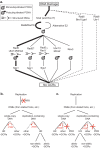Post-replication repair suppresses duplication-mediated genome instability
- PMID: 20463880
- PMCID: PMC2865514
- DOI: 10.1371/journal.pgen.1000933
Post-replication repair suppresses duplication-mediated genome instability
Abstract
RAD6 is known to suppress duplication-mediated gross chromosomal rearrangements (GCRs) but not single-copy sequence mediated GCRs. Here, we found that the RAD6- and RAD18-dependent post-replication repair (PRR) and the RAD5-, MMS2-, UBC13-dependent error-free PRR branch acted in concert with the replication stress checkpoint to suppress duplication-mediated GCRs formed by homologous recombination (HR). The Rad5 helicase activity, but not its RING finger, was required to prevent duplication-mediated GCRs, although the function of Rad5 remained dependent upon modification of PCNA at Lys164. The SRS2, SGS1, and HCS1 encoded helicases appeared to interact with Rad5, and epistasis analysis suggested that Srs2 and Hcs1 act upstream of Rad5. In contrast, Sgs1 likely functions downstream of Rad5, potentially by resolving DNA structures formed by Rad5. Our analysis is consistent with models in which PRR prevents replication damage from becoming double strand breaks (DSBs) and/or regulates the activity of HR on DSBs.
Conflict of interest statement
The authors have declared that no competing interests exist.
Figures


Similar articles
-
The Saccharomyces cerevisiae Rad6 postreplication repair and Siz1/Srs2 homologous recombination-inhibiting pathways process DNA damage that arises in asf1 mutants.Mol Cell Biol. 2009 Oct;29(19):5226-37. doi: 10.1128/MCB.00894-09. Epub 2009 Jul 27. Mol Cell Biol. 2009. PMID: 19635810 Free PMC article.
-
Suppression of genetic defects within the RAD6 pathway by srs2 is specific for error-free post-replication repair but not for damage-induced mutagenesis.Nucleic Acids Res. 2002 Feb 1;30(3):732-9. doi: 10.1093/nar/30.3.732. Nucleic Acids Res. 2002. PMID: 11809886 Free PMC article.
-
The Rad5 helicase activity is dispensable for error-free DNA post-replication repair.DNA Repair (Amst). 2014 Apr;16:74-83. doi: 10.1016/j.dnarep.2014.02.016. Epub 2014 Mar 13. DNA Repair (Amst). 2014. PMID: 24674630
-
Error-free DNA-damage tolerance in Saccharomyces cerevisiae.Mutat Res Rev Mutat Res. 2015 Apr-Jun;764:43-50. doi: 10.1016/j.mrrev.2015.02.001. Epub 2015 Feb 16. Mutat Res Rev Mutat Res. 2015. PMID: 26041265 Review.
-
Multifunctional roles of Saccharomyces cerevisiae Srs2 protein in replication, recombination and repair.FEMS Yeast Res. 2017 Mar 1;17(2):fow111. doi: 10.1093/femsyr/fow111. FEMS Yeast Res. 2017. PMID: 28011904 Free PMC article. Review.
Cited by
-
Essential Saccharomyces cerevisiae genome instability suppressing genes identify potential human tumor suppressors.Proc Natl Acad Sci U S A. 2019 Aug 27;116(35):17377-17382. doi: 10.1073/pnas.1906921116. Epub 2019 Aug 13. Proc Natl Acad Sci U S A. 2019. PMID: 31409704 Free PMC article.
-
Yeast Genome Maintenance by the Multifunctional PIF1 DNA Helicase Family.Genes (Basel). 2020 Feb 20;11(2):224. doi: 10.3390/genes11020224. Genes (Basel). 2020. PMID: 32093266 Free PMC article. Review.
-
Pathways and Mechanisms that Prevent Genome Instability in Saccharomyces cerevisiae.Genetics. 2017 Jul;206(3):1187-1225. doi: 10.1534/genetics.112.145805. Genetics. 2017. PMID: 28684602 Free PMC article. Review.
-
Genetic instability in budding and fission yeast-sources and mechanisms.FEMS Microbiol Rev. 2015 Nov;39(6):917-67. doi: 10.1093/femsre/fuv028. Epub 2015 Jun 24. FEMS Microbiol Rev. 2015. PMID: 26109598 Free PMC article. Review.
-
Telomere Interacting Proteins and TERRA Regulation.Front Genet. 2022 Apr 8;13:872636. doi: 10.3389/fgene.2022.872636. eCollection 2022. Front Genet. 2022. PMID: 35464834 Free PMC article. Review.
References
-
- Rupp WD, Howard-Flanders P. Discontinuities in the DNA synthesized in an excision-defective strain of Escherichia coli following ultraviolet irradiation. J Mol Biol. 1968;31:291–304. - PubMed
-
- Rupp WD, Wilde CE, 3rd, Reno DL, Howard-Flanders P. Exchanges between DNA strands in ultraviolet-irradiated Escherichia coli. J Mol Biol. 1971;61:25–44. - PubMed
-
- di Caprio L, Cox BS. DNA synthesis in UV-irradiated yeast. Mutat Res. 1981;82:69–85. - PubMed
-
- Andersen PL, Xu F, Xiao W. Eukaryotic DNA damage tolerance and translesion synthesis through covalent modifications of PCNA. Cell Res. 2008;18:162–173. - PubMed
Publication types
MeSH terms
Substances
Grants and funding
LinkOut - more resources
Full Text Sources
Molecular Biology Databases
Research Materials
Miscellaneous

